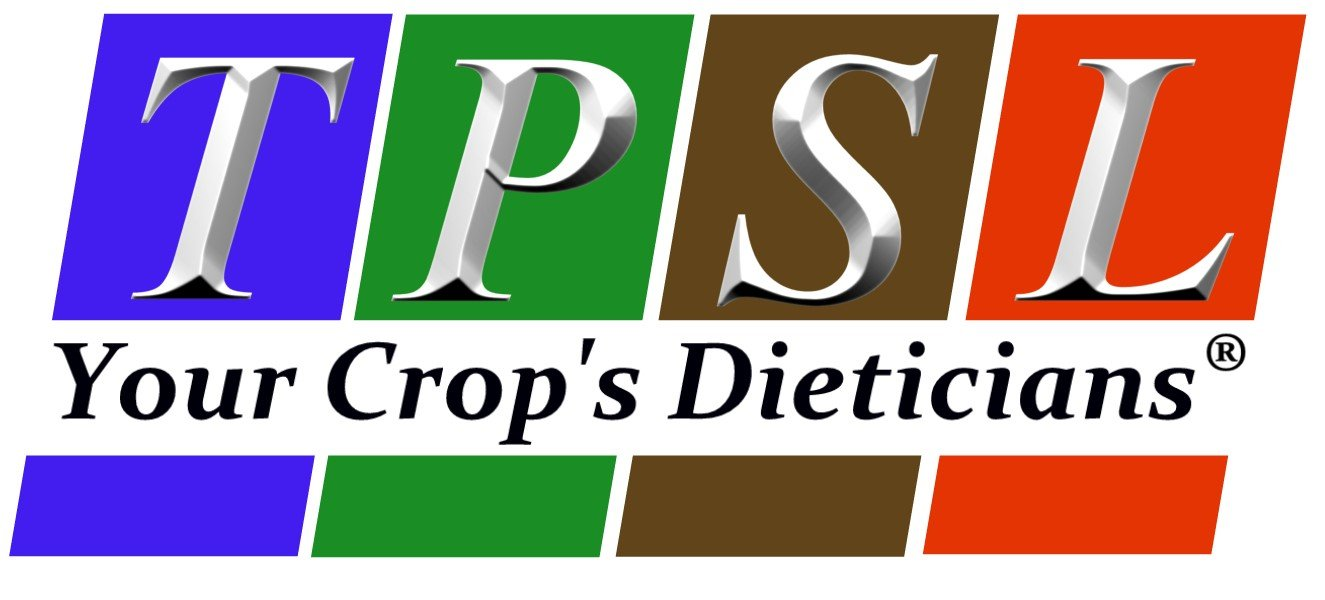Crop Monitoring Programs to help you plan your season.
Soybeans have a high profit potential. Since approximately 90% of production costs for soybeans are incurred at the 30 bushel yield level, growers should be able to economically fertilize for maximum yields. Fertility programs based on plant analysis and soil analysis from TPSL® will maximize mineral efficiency.
Seasonal Requirements for Soybeans
| Yield (bu./A) | Nitrogen lbs/ac | Phosphorus lbs/ac | Potassium lbs/ac | Magnesium lbs/ac | Sulfur lbs/ac |
|---|---|---|---|---|---|
| 50 | 270 | 55 | 120 | 25 | 21 |
| 75 | 405 | 83 | 180 | 38 | 32 |
| 100 | 540 | 110 | 240 | 50 | 42 |
| 125 | 675 | 138 | 300 | 63 | 53 |
| 150 | 810 | 165 | 360 | 75 | 63 |
| 200 | 1080 | 220 | 480 | 100 | 84 |
* IMPORTANT NOTES ABOUT THIS TABLE *
♦ The numbers shown were compiled from several different sources and are approximate only. The table is presented for rough planning purposes. ♦ Actual demands for some of the nutrients shown can vary dramatically and be reduced, depending upon the timing of applications, soil and irrigation water chemistry, and growing conditions. ♦ To achieve best crop quality and yields, regular ASK THE PLANT® leaf testing at critical stages of physiological plant development during the growing season is crucial. ♦ To achieve yield goals, it is essential to accommodate the plants’ changing nutritional demands by providing adequate amounts of only those nutrients that are needed when they are needed.
Soybeans absorb approximately 40 to 45% of their total N, P & K at the beginning of bean formation, when the vegetative plant parts have reached their maximum content. All of these nutrients go into the seed because the grain contains approximately 70% N, 75% P, and 55% K of all the nutrients absorbed.
During the first month of planting, daily nutrient uptakes are small – much less than 1 lb./acre/day. In the second and third month, the daily nutrient requirement can reach 8 lbs. Nitrogen, 0.40 lbs. Phosphorous, and 4 lbs. of Potash.
At soybean yields of 30 to 70 bushels/acre, 1/3 to1/2 (yields above this are proportionately higher) of the Nitrogen absorbed by the plant is in the form of nitrates and ammonium ions. Pre-plant Nitrogen is recommended depending upon soil analysis results. Phosphate and Potassium should be included with nitrogen soil applications. Since peak Nitrogen uptake corresponds with pod set and seed filling, supplemental Nitrogen is recommended during these stages of growth.
High levels of available Phosphorous are associated with high soybean yields. The greatest demand for Phosphorous is at mid-bloom and mid-pod set. Phosphorous is required for normal Nitrogen fixation. Average mineral recovery from fertilization under good conditions ranges from 10 to 20%. TPSL® has successful in increasing this percentage, especially in drip and pivot irrigation, by using adjuvants such as humic acid, sugars, beneficial soil bacteria and other things.
The SOIL TEST - Depending upon your soil’s chemistry, most nutrients can be rapidly “tied-up” into plant-unavailable (insoluble) compounds! It is only the plant-available nutrient compounds – available when the plants need them - that count! Most all other soil tests report at least some amount of those “tied-up / plant-unavailable” compounds, giving you a false sense of adequacy – even as your plants show obvious signs of distress and decline! This hopefully explains why your plants clearly show certain nutrient deficiencies, even though your soil test reports come back showing those nutrients as being adequate or high! All of this can be avoided!
PLANT TESTING - Three Critical Stages in Soybeans.
Seedling stage (less than 12″)
Entire above ground portion.
20-30 plants
Early season tissue analysis is needed because nutrients are remobilized from leaf and stem tissue to the seed.
• Peak absorption of K takes place the 12-15 days from flowering to early pod development and can range from 5 to 8 pounds per acre per day.
• Demand for N and P is greatest between pod filling to maturity with 45% of their uptake occurring during these growth stages.
• Like that of all macro and secondary nutrients, soybean demand Zn, B, Mn, Cu and Fe is greatest near R3, while early season demand is extremely low.
R1 to R2 (initial to full flowering)
Two or three fully developed leaves at the top of the plant.
20-30 upper leaves
Sample the most recently matured leaf near the top of the plant. Keep both the petiole and leaf for the sample.
Approximately 25 to 35 leaves are needed for one sample.
Repeat sampling every 10 days. Only paper, not plastic, bags should be used. Samples should be taken from early growth to pod development.
After R5.
Two or three fully developed leaves at the top of the plant.
20-30 upper leaves
5, vegetative Zn and Cu remobilization is greatest, while Mn and B remobilization to the seed is minimal and Fe has no mobility to the developing seed
• Uptake after R5 of Mn and Fe is 83 and 100%, respectively, of the seeds’ demand for these nutrients. Zn, Cu, and B still met the majority (>50%) of seed nutrient demand through uptake past R5, signifying the importance of season long micronutrient availability, although in small amounts.
Join Our Mailing List
Thank you for joining our mailing list. You will now begin to receive event announcements, newsletters and all of our latest updates.
Please try again later.
Email Us
For general inquiries and questions, contact us via email.
(956) 383-0739info@tpslab.com
Refund Policy
Billing Terms and Conditions
All Rights Reserved | TPSL







